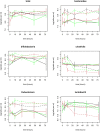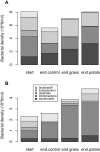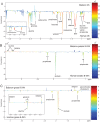Impacts of plant-based foods in ancestral hominin diets on the metabolism and function of gut microbiota in vitro
- PMID: 24846385
- PMCID: PMC4030449
- DOI: 10.1128/mBio.00853-14
Impacts of plant-based foods in ancestral hominin diets on the metabolism and function of gut microbiota in vitro
Abstract
Ancestral human populations had diets containing more indigestible plant material than present-day diets in industrialized countries. One hypothesis for the rise in prevalence of obesity is that physiological mechanisms for controlling appetite evolved to match a diet with plant fiber content higher than that of present-day diets. We investigated how diet affects gut microbiota and colon cells by comparing human microbial communities with those from a primate that has an extreme plant-based diet, namely, the gelada baboon, which is a grazer. The effects of potato (high starch) versus grass (high lignin and cellulose) diets on human-derived versus gelada-derived fecal communities were compared in vitro. We especially focused on the production of short-chain fatty acids, which are hypothesized to be key metabolites influencing appetite regulation pathways. The results confirmed that diet has a major effect on bacterial numbers, short-chain fatty acid production, and the release of hormones involved in appetite suppression. The potato diet yielded greater production of short-chain fatty acids and hormone release than the grass diet, even in the gelada cultures, which we had expected should be better adapted to the grass diet. The strong effects of diet on hormone release could not be explained, however, solely by short-chain fatty acid concentrations. Nuclear magnetic resonance spectroscopy found changes in additional metabolites, including betaine and isoleucine, that might play key roles in inhibiting and stimulating appetite suppression pathways. Our study results indicate that a broader array of metabolites might be involved in triggering gut hormone release in humans than previously thought.
Importance: One theory for rising levels of obesity in western populations is that the body's mechanisms for controlling appetite evolved to match ancestral diets with more low-energy plant foods. We investigated this idea by comparing the effects of diet on appetite suppression pathways via the use of gut bacterial communities from humans and gelada baboons, which are modern-day primates with an extreme diet of low-energy plant food, namely, grass. We found that diet does play a major role in affecting gut bacteria and the production of a hormone that suppresses appetite but not in the direction predicted by the ancestral diet hypothesis. Also, bacterial products were correlated with hormone release that were different from those normally thought to play this role. By comparing microbiota and diets outside the natural range for modern humans, we found a relationship between diet and appetite pathways that was more complex than previously hypothesized on the basis of more-controlled studies of the effects of single compounds.
Copyright © 2014 Frost et al.
Figures







Similar articles
-
Dietary glycation compounds - implications for human health.Crit Rev Toxicol. 2024 Sep;54(8):485-617. doi: 10.1080/10408444.2024.2362985. Epub 2024 Aug 16. Crit Rev Toxicol. 2024. PMID: 39150724
-
Apparent total tract macronutrient digestibility of mildly cooked human-grade vegan dog foods and their effects on the blood metabolites and fecal characteristics, microbiota, and metabolites of adult dogs.J Anim Sci. 2023 Jan 3;101:skad093. doi: 10.1093/jas/skad093. J Anim Sci. 2023. PMID: 36970938 Free PMC article.
-
Differences in Gut Metabolites and Microbial Composition and Functions between Egyptian and U.S. Children Are Consistent with Their Diets.mSystems. 2017 Feb 7;2(1):e00169-16. doi: 10.1128/mSystems.00169-16. eCollection 2017 Jan-Feb. mSystems. 2017. PMID: 28191503 Free PMC article.
-
Functional properties of miscanthus fiber and prebiotic blends in extruded canine diets.J Anim Sci. 2022 Apr 1;100(4):skac078. doi: 10.1093/jas/skac078. J Anim Sci. 2022. PMID: 35279717 Free PMC article.
-
Short-chain fatty acids as a link between diet and cardiometabolic risk: a narrative review.Lipids Health Dis. 2023 Mar 14;22(1):40. doi: 10.1186/s12944-023-01803-5. Lipids Health Dis. 2023. PMID: 36915164 Free PMC article. Review.
Cited by
-
Manipulation of Gut Microbiota Using Acacia Gum Polysaccharide.ACS Omega. 2021 Jul 2;6(28):17782-17797. doi: 10.1021/acsomega.1c00302. eCollection 2021 Jul 20. ACS Omega. 2021. PMID: 34308014 Free PMC article.
-
Impact of inorganic iron and haem on the human gut microbiota; An in vitro batch-culture approach.Front Microbiol. 2023 Feb 23;14:1074637. doi: 10.3389/fmicb.2023.1074637. eCollection 2023. Front Microbiol. 2023. PMID: 36910170 Free PMC article.
-
Effect of in vitro cultivation on human gut microbiota composition using 16S rDNA amplicon sequencing and metabolomics approach.Sci Rep. 2023 Feb 21;13(1):3026. doi: 10.1038/s41598-023-29637-2. Sci Rep. 2023. PMID: 36810418 Free PMC article.
-
Butyrate: A Double-Edged Sword for Health?Adv Nutr. 2018 Jan 1;9(1):21-29. doi: 10.1093/advances/nmx009. Adv Nutr. 2018. PMID: 29438462 Free PMC article. Review.
-
Prebiotics Modulate the Effects of Antibiotics on Gut Microbial Diversity and Functioning in Vitro.Nutrients. 2015 Jun 4;7(6):4480-97. doi: 10.3390/nu7064480. Nutrients. 2015. PMID: 26053617 Free PMC article.
References
-
- Kant AK. 2000. Consumption of energy-dense, nutrient-poor foods by adult Americans: nutritional and health implications. The third National Health and Nutrition Examination Survey, 1988-1994. Am. J. Clin. Nutr. 72:929–936 - PubMed
-
- Institute of Medicine 2005. Dietary reference intakes for energy, carbohydrate, fiber, fat, fatty acids, cholesterol, protein, and amino acids (macronutrients). National Academies Press, Washington, DC - PubMed
Publication types
MeSH terms
Substances
Grants and funding
LinkOut - more resources
Full Text Sources
Other Literature Sources

